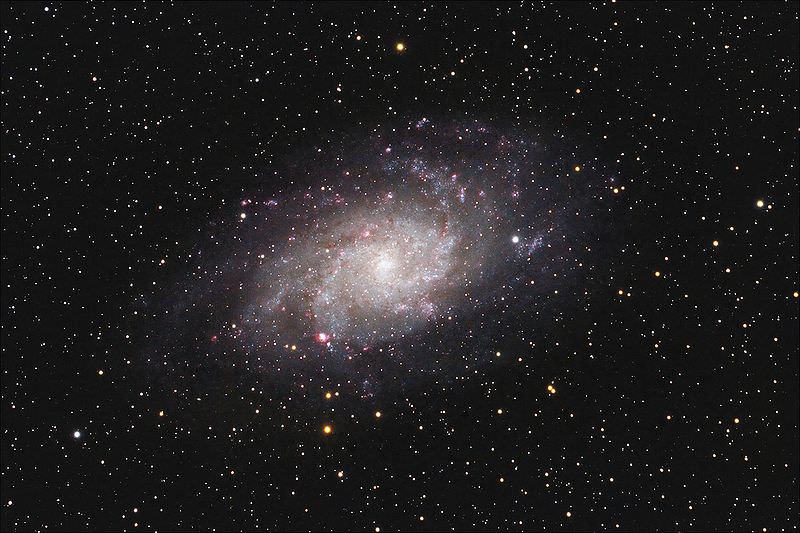The spiral galaxy M33 is one of the largest galaxies in our local group. This spiral galaxy is moderately tilted when viewed from Earth, displaying a lack of a distinct central bulge but prominent spiral arms. It has only one potential companion galaxy (the Pisces Dwarf) and its spiral arms are so pristine, they have been thought to be unperturbed by the accretion of dwarf galaxies that constantly occurs in the Milky Way and Andromeda galaxy. Yet these features are what has made M33 so hard to explain. Since larger galaxies are expected to form from the merger of smaller galaxies it is expected that M33 should show some scars from previous mergers. If this picture is true, where are they?
The role of galaxy accretion in our own galaxy was first revealed in 1994 with the discovery of the Sagittarius stellar stream. With the completion of the first Sloan Digitised Sky Survey, many more tidal streams were revealed in our own galaxy. Modeling of the kinematics of these streams suggested they should last billions of years before fading into the rest of the galaxy. Deep imaging of the Andromeda galaxy revealed stellar streams as well as a notable warping of the disc of the galaxy.
Yet M33 seems to lack obvious signs of these structures. In 2006, a spectroscopic study analyzed the bright red giants in the galaxy and found three distinct populations. One could be attributed to the disc, one to the halo, but the third was not immediately explicable. Could this be the relic of an ancient satellite?
Another potential clue on missing mergers was discovered in 2005 when a radio survey around M33 was conducted with the Arecibo telescope. This study uncovered large clouds with a thousand to a million solar masses worth of raw hydrogen suspended around the galaxy. Might these be incomplete dwarf galaxies that never merged into M33? A new study uses the Subaru telescope atop Mauna Kea to study these regions as well as the outskirts of M33 to better understand their history.
The team, led by Marco Grossi at the Observatório Astronómico de Lisboa in Portugal, did not find evidence of a stellar population in these clouds suggesting they were not likely to be galaxies in their own right. Instead, they suggest that these clouds may be analogous to hydrogen clouds around the Milky Way and Andromeda which are “often found close to stellar streams or disturbances in the stellar disc” where gas is pulled from a former satellite galaxy through tidal or ram-pressure stripping. This would constitute another piece of indirect evidence that M33 once underwent mergers of some sort.
Outside of these clouds, in the outskirts of the galaxy, the team uncovered a diverse population of stars beyond the main disc. The overall metallicity of these stars was lower, but it also included some younger stars. At such a distance, these young stars would not be expected unless accreted.
While this finding doesn’t fully answer the question of how M33 may have formed, it does reveal that this galaxy has likely not evolved in the isolation previously assumed.


Yo Jon, at the third paragraph, third line, it’s the Pisces Dwarf, not “Pices”.
Good article. Strange title.
“While this finding doesn’t fully answer the question of how M33 may have formed, it does reveal that this galaxy has likely not evolved in the isolation previously assumed.”
I wonder if a past gravitational encounter with M31 may be responsible for some of the peculiarities mentioned in the article? An *apparent* bridge of HI has been discovered between the two galaxies; a paper by Bekki looks at some models of a past tidal interaction with M31. Their models suggest accretion of HI from M33 may account for some of the newly discovered stellar streams in M31: http://arxiv.org/PS_cache/arxiv/pdf/0807/0807.1161v1.pdf
A recent study of globular clusters in M33 also revealed the paucity of such systems in M33 suggested either tidal stripping from a tidal encounter with M31 or a “very different, much calmer accretion history of M33” (but leaning toward tidal encounter): http://arxiv.org/PS_cache/arxiv/pdf/1101/1101.2450v1.pdf
With it’s larger mass, maybe M31 stripped M33 of many of it’s dwarf galaxies, accounting for the lack of stellar streams around M33. The second paper also notes that, unlike the Milky Way or M31, all of the clusters in M33 were of intermediate age or younger. Again, the age of galactic clusters in M33 might also be indicative of a past interaction.
Whatever turns out to be the case, I’ll still enjoy the view of the “Triangulum Galaxy” in my small scope (especially on those cool, crisp autumn nights in the northern hemisphere).
The large HI clouds connected to M33 suggest tidal interactions in the past. The globular clusters might then have been lost in close encounters with M31 or our galaxy. It has been my understanding that large galaxies were built up by accumulations of smaller ones. So I might conjecture that M33 is a remnant of ancient galactic structures which emerged in the first few billion years.
LC